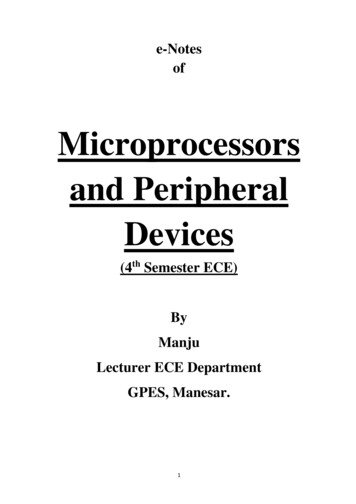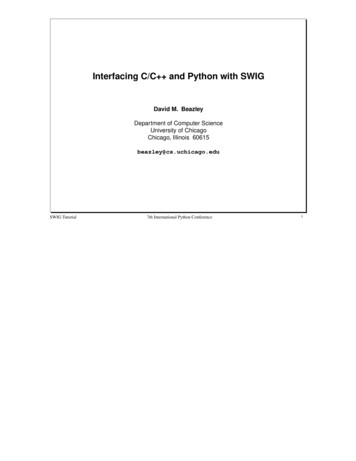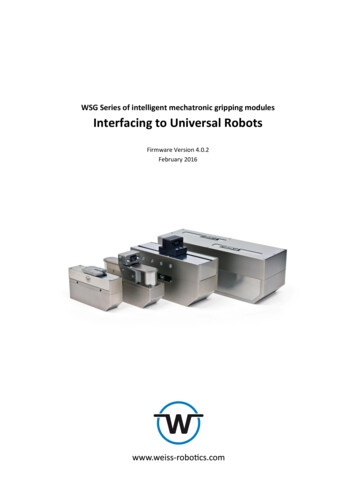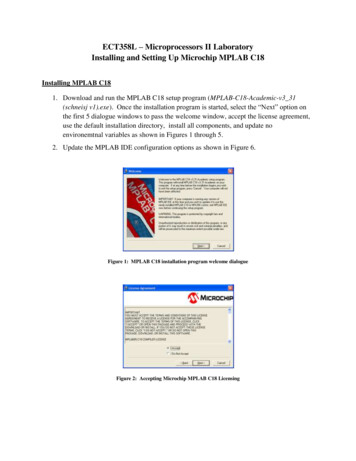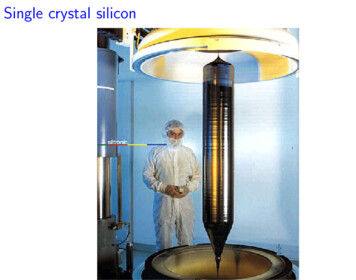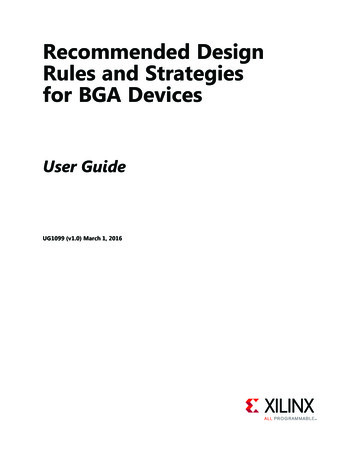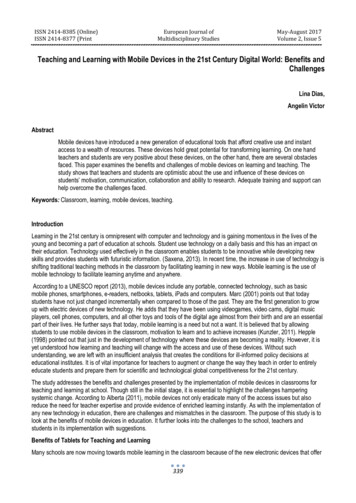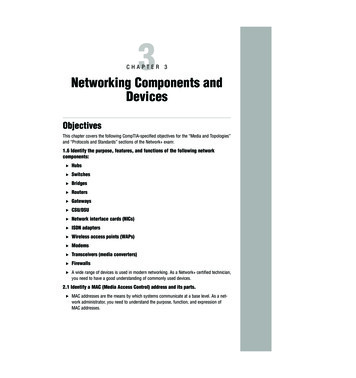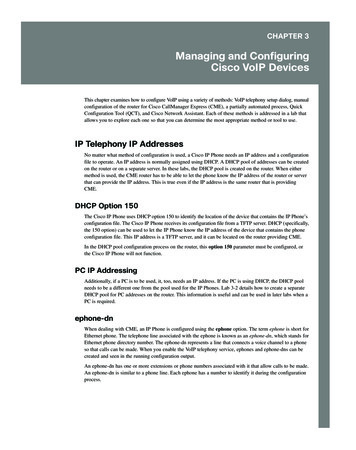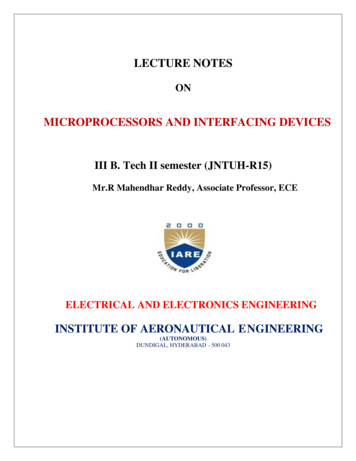
Transcription
LECTURE NOTESONMICROPROCESSORS AND INTERFACING DEVICESIII B. Tech II semester (JNTUH-R15)Mr.R Mahendhar Reddy, Associate Professor, ECEELECTRICAL AND ELECTRONICS ENGINEERINGINSTITUTE OF AERONAUTICAL ENGINEERING(AUTONOMOUS)DUNDIGAL, HYDERABAD - 500 043
Syllabus:JAWAHARLAL NEHRU TECHNOLOGICAL UNIVERSITY HYDERABADL4III Year B.Tech. ECE -II SemT/ /P/D C-/-/4MICROPROCESSORS AND INTERRFACING DEVICESUNIT – I8086 MICROPROCESSOR:8086 architecture- Functional Diagram, Register Organization, Memory segmentation, Memory addresses,physical memory organization, Signal descriptions of 8086-common function signals, Minimum andMaximum mode signals, Read Write cycles, Timing diagrams, Interrupt structure of 8086.UNIT – IIASSEMBLY LANGUAGE PROGRAMMING OF 8086:Instruction formats, addressing modes, instruction set, assembler directives, macros, Simple programsinvolving logical, branch and call instructions, Sorting, evaluating arithmetic expressions, stringmanipulations.UNIT – IIIPERIPHERAL INTERFACING WITH 8086 MICROPROCESSOR:8255 PPI, Keyboard, display controllers, Stepper motor, A/D & D/A Converter Interfacing with 8086microprocessor.Static and Dynamic memories, Vector interrupt table, Interrupt service routine, Introduction to DOS & BIOSinterrupts, Programmable Interrupt Controller 8259,DMA controller 8257 Interfacing with8086microprocessor.UNIT – IVCOMMUNICATION INTERFACE:Serial communication standards, serial data transfer schemes, 8251 USART architecture and Interfacing, RS232, IEEE-488, prototyping and trouble shooting.UNIT – VINTRODUCTION TO MICROCONTROLLERS:Overview of 8051 microcontroller, Architecture, I/O ports and Memory organization, addressing modes andinstruction set of 8051, Simple programs.
UNIT-I8086 ARCHITECTUREIntroduction to processor: A processor is the logic circuitry that responds to and processes the basic instructions thatdrives a computer.The term processor has generally replaced the term central processing unit (CPU). Theprocessor in a personal computer or embedded in small devices is often called amicroprocessor.The processor (CPU, for Central Processing Unit) is the computer's brain. It allows theprocessing of numeric data, meaning information entered in binary form, and the executionof instructions stored in memory.Evolution of Microprocessor:A microprocessor is used as the CPU in a microcomputer. There are now many differentmicroprocessors available. Microprocessor is a program-controlled device, which fetches the instructions from memory,decodes and executes the instructions. Most Micro Processor are single- chip devices. Microprocessor is a backbone of computer system. which is called CPU Microprocessor speed depends on the processing speed depends on DATA BUS WIDTH. A common way of categorizing microprocessors is by the no. of bits that their ALU canWork with at a time The address bus is unidirectional because the address information is always given by theMicro Processor to address a memory location of an input / output devices. The data bus is Bi-directional because the same bus is used for transfer of data betweenMicro Processor and memory or input / output devices in both the direction. It has limitations on the size of data. Most Microprocessor does not support floating-pointoperations. Microprocessor contain ROM chip because it contain instructions to execute data. What is the primary & secondary storage device? - In primary storage device the Storage capacity is limited. It has a volatile memory. In secondary storage device the storagecapacity is larger. It is a nonvolatile memory.a) Primary devices are: RAM (Read / Write memory, High Speed, Volatile Memory)/ ROM (Read only memory, Low Speed, Non Voliate Memory)b) Secondary devices are: Floppy disc / Hard diskCompiler: Compiler is used to translate the high-level language program into machine code at atime. It doesn’t require special instruction to store in a memory, it stores automatically. TheExecution time is less compared to Interpreter.1.4-bit Microprocessor: The first microprocessor (Intel 4004) was invented in 1971. It was a 4-bit calculation devicewith a speed of 108 kHz. Since then, microprocessor power has grown exponentially. So
what exactly are these little pieces of silicone that run our computers(" Common OperatingMachine Particularly Used For Trade Education And Research ") It has 3200 PMOS transistors. It is a 4-bit device used in calculator.2.8-Bit microprocessor: In 1972, Intel came out with the 8008 which is 8-bit. In 1974, Intel announced the 8080 followed by 8085 is a 8-bit processor Because 8085processor has 8 bit ALU (Arithmetic Logic Review). Similarly 8086 processor has 16 bitALU. This had a larger instruction set then 8080. used NMOS transistors, so it operatedmuch faster than the 8008.The 8080 is referred to as a “Second generation Microprocessor”3. Limitations of 8 Bit microprocessor: Low speed of execution Low memory addressing capability Limited number of general purpose registers Less power full instruction set4. Examples for 4/ 8 / 16 / 32 bit Microprocessors: 4-Bit processor – 4004/4040 8-bit Processor - 8085 / Z80 / 6800 16-bit Processor - 8086 / 68000 / Z8000 32-bit Processor - 80386 / 804865. What are 1st / 2nd / 3rd / 4th generation processor? The processor made of PMOS technology is called 1st generation processor, and it is made upof 4 bits The processor made of NMOS technology is called 2nd generation processor, and it is madeup of 8 bits The processor made of CMOS technology is called 3rd generation processor, and it is madeup of 16 bits The processor made of HCMOS technology is called 4th generation processor, and it is madeup of 32 bits (HCMOS : High-density n- type Complementary Metal Oxide Silicon fieldeffect transistor)Block diagram of microprocessor:
The Central Processing Unit (CPU):This device coordinates all operations of a micro computer. It fetches programs stored inROM‟s or RAMs and executes the instructions depending one a specific Instructions set,which is characteristic of each type of CPU, and which is recognized by the CPU.The Random Access Memory (RAM): Temporary or trail programs are written.Besides the ROM area, every computer has some memory space for temporary storage ofdata as well as for programs under development. These memory devices are RAMs or Read – writememory. The contents of it are not permanent and are altered when power is turned off. So the RAMmemory is considered to be volatile memory.The Read Only Memory (ROM): Permanent programs are stored.The permanent memory device/area is called ROM, because whatever be the memorycontents of ROMs, they cannot be over written with some other information.For a blank ROM, the manufacturer supplies the device without any inf. In it, informationcan be entered electrically into the memory space. This is called burning a ROM or PROM.Data Lines/Data Bus:The number of data lines, like add. Lines vary with the specific CPU .The set of data linesis database like the address bus unlike add. Bus, the data bus is bidirectional because while theinformation on the address Bus always flows out of the CPU; the data can flow both out of the CPUas well as into the CPU.Control lines/ control Bus:The no. of control lines also depends on the specific CPU one is using.Ex: Read; Write lines are examples of control linesClock: The clock is a symmetrical square wave signal that drives the CPUInstructions: An instruction is an elementary operation that the processor can accomplish.Instructions are stored in the main memory, waiting to be processed by the processor. An instructionhas two fields: Operation code, which represents the action that the processor must execute;Operand code, which defines the parameters of the action. The operand code depends on theoperation. It can be data or a memory addressIntroduction to 8085 Microprocessor:The Salient Features of 8085 Microprocessor: 8085 is an 8 bit microprocessor, manufactured with N-MOS technology. It has 16-bit address bus and hence can address up to 216 65536 bytes (64KB)memory locations through A0-A15. The first 8 lines of address bus and 8 lines of data bus are multiplexed AD0 - AD7.Data bus is a group of 8 lines D0 - D7. It supports external interrupt request.8085 consists of 16 bit program counter (PC)and stack pointer (SP). Six 8-bit general purpose register arranged in pairs: BC, DE, HL. It requires a signal 5V power supply and can operate at 3 MHz, 5 MHz and 6MHz Serial in/Serial out Port. It is enclosed with 40 pins DIP (Dual in line package).
Internal Architecture of 8085:8085 Bus Structure: Address Bus: The address bus is a group of 16 lines generally identified as A0 to A15. The address bus is unidirectional: bits flow in one direction-from the MPU to peripheraldevices.The MPU uses the address bus to perform the first function: identifying a peripheral or amemory location. Data Bus: The data bus is a group of eight lines used for data flow. These lines are bi-directional - data flow in both directions between the MPU andmemory and peripheral devices.The MPU uses the data bus to perform the second function: transferring binaryinformation.The eight data lines enable the MPU to manipulate 8-bit data ranging from 00 to FF (28 256 numbers).The largest number that can appear on the data bus is 11111111.
Control Bus: The control bus carries synchronization signals and providing timing signals. The MPU generates specific control signals for every operation it performs. These signalsare used to identify a device type with which the MPU wants to communicate.Registers of 8085: The 8085 have six general-purpose registers to store 8-bit data during program execution. These registers are identified as B, C, D, E, H, and L. They can be combined as register pairs-BC, DE, and HL-to perform some 16-bitoperations.Accumulator (A): The accumulator is an 8-bit register that is part of the arithmetic/logic unit (ALU). This register is used to store 8-bit data and to perform arithmetic and logical operations. The result of an operation is stored in the accumulator.Flags: The ALU includes five flip-flops that are set or reset according to the result of anoperation. The microprocessor uses the flags for testing the data conditions. They are Zero (Z), Carry (CY), Sign (S), Parity (P), and Auxiliary Carry (AC) flags. Themost commonly used flags are Sign, Zero, and Carry.The bit position for the flags in flag register is,1. Sign Flag (S):After execution of any arithmetic and logical operation, if D7 of the result is 1, the sign flagis set. Otherwise it is reset.D7 is reserved for indicating the sign; the remaining is the magnitude of number.If D7 is 1, the number will be viewed as negative number. If D7 is 0, the number will beviewed as positive number.
2. Zero Flag (z):If the result of arithmetic and logical operation is zero, then zero flag is set otherwise it isreset.3. Auxiliary Carry Flag (AC):If D3 generates any carry when doing any arithmetic and logical operation, this flag is set.Otherwise it is reset.4. Parity Flag (P):If the result of arithmetic and logical operation contains even number of 1's then this flagwill be set and if it is odd number of 1's it will be reset.5. Carry Flag (CY):If any arithmetic and logical operation result any carry then carry flag is set otherwise it isreset.Arithmetic and Logic Unit (ALU): It is used to perform the arithmetic operations like addition, subtraction, multiplication,division, increment and decrement and logical operations like AND, OR and EX-OR. It receives the data from accumulator and registers. According to the result it set or reset the flags.Program Counter (PC): This 16-bit register sequencing the execution of instructions. It is a memory pointer. Memory locations have 16-bit addresses, and that is why this is a16-bit register. The function of the program counter is to point to the memory address of the nextinstruction to be executed. When an opcode is being fetched, the program counter is incremented by one to point tothe next memory location.Stack Pointer (SP): The stack pointer is also a 16-bit register used as a memory pointer. It points to a memory location in R/W memory, called the stack. The beginning of the stack is defined by loading a 16-bit address in the stack pointer(register).Temporary Register: It is used to hold the data during the arithmetic and logical operations.Instruction Register: When an instruction is fetched from the memory, it is loaded in theinstruction register.Instruction Decoder: It gets the instruction from the instruction register and decodes theinstruction. It identifies the instruction to be performed.Serial I/O Control: It has two control signals named SID and SOD for serial data transmission.Timing and Control unit: It has three control signals ALE, RD (Active low) and WR (Active low) and three statussignals IO/M(Active low), S0 and S1. ALE is used for provide control signal to synchronize the components of microprocessorand timing for instruction to perform the operation.
RD (Active low) and WR (Active low) are used to indicate whether the operation isreading the data from memory or writing the data into memory respectively.IO/M(Active low) is used to indicate whether the operation is belongs to the memory orperipherals.If,Interrupt Control Unit: It receives hardware interrupt signals and sends an acknowledgement for receiving theinterrupt signal.Pin Diagram and Pin Description Of 80858085 is a 40 pin IC, DIP package. The signals from the pins can be grouped as follows1. Power supply and clock signals2. Address bus3. Data bus4. Control and status signals5. Interrupts and externally initiated signals6. Serial I/O ports
1. Power supply and clock frequency signals Vcc 5 volt power supplyVssGroundX1, X2: Crystal or R/C network or LC network connections to set thefrequency of internal clock generator.The frequency is internally divided
1.4-bit Microprocessor: The first microprocessor (Intel 4004) was invented in 1971. It was a 4-bit calculation device with a speed of 108 kHz. Since then, microprocessor power has grown exponentially. So . what exactly are these little pieces of silicone that run our computers(" Common Operating Machine Particularly Used For Trade Education And Research ") It has 3200 PMOS transistors. It is a .
